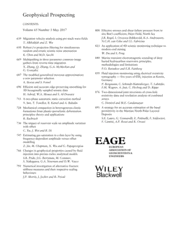-
oa An application of 4D seismic monitoring technique to modern coal mining
- Source: Geophysical Prospecting, Volume 65, Issue 3, Apr 2017, p. 823 - 839
-
- 01 Apr 2015
- 01 Jul 2016
- 13 Sep 2016
Abstract
To study the impact of modern coal mining on the overlying formation, a full‐life‐cycle four‐dimensional seismic monitoring study has been carried out. Four seismic data campaigns have been performed using flexi‐bin geometry with square bins, with total duration of 171 days. The four seismic datasets have been processed with the same processing workflow and parameters; major problems such as statics correction, signal‐to‐noise ratio, resolution, and consistency processing are addressed taking into account the geological features of the research area. This guarantees that remaining four‐dimensional differences between the time‐lapse datasets show mostly geological factors due to the coal mining and effects such as surface subsidence. Our four‐dimensional seismic monitoring of modern coal mining shows that mined and unmined areas have significant zoning characteristics; coal mining has a direct impact on the overlying formation. The mining leads to obvious event subsidence, which reflects that overlying formations undergo subsidence during the mining process. The overlying formation appears as two zones called caving zone and fractured zone. We determine the fault dip of the overlying formation at one end of the working face to be 56°or so by calculation and conversion. We also see that, during the coal mining process, over time, the overlying formation has a self‐recovery capability, which gradually strengthens from the roof siltstone upward to the Aeolian sandstone near the surface. The stability of 20‐m coal pillars between working faces displays a strengthening trend and remains safe during the mining process due to both coal seam supporting and formation compaction effects.



